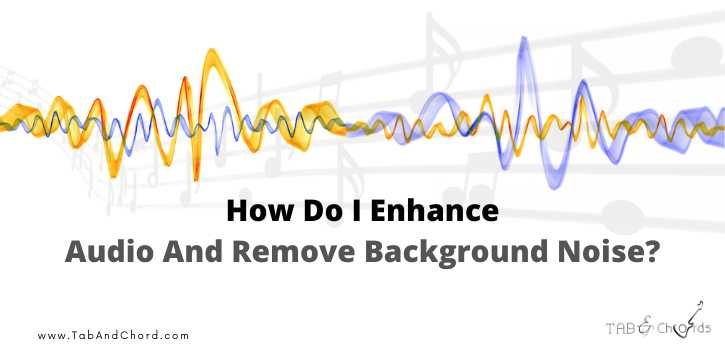How Do I Enhance Audio And Remove Background Noise?
Background noise can be a pesky nuisance that undermines the quality of audio recordings. Whether you’re a professional sound engineer or an aspiring podcaster, the quest to enhance audio and remove background noise is a crucial skill to master.
This article will explore the techniques and tools necessary to achieve pristine audio quality.
Before diving into the technicalities, it is essential to understand the different types of background noise that can plague your recordings. Identifying the source is the first step toward effective noise reduction from electrical hums to ambient room noise.
To combat background noise, noise reduction software is a powerful tool. With advanced algorithms and filters, these software programs can intelligently identify and suppress unwanted noise, leaving clear and crisp audio behind.
So, let’s embark on this journey to enhance audio and bid farewell to background noise once and for all.
Key Takeaways
- Understanding different types of background noise is crucial for effective noise reduction
- High-quality microphone and proper microphone placement can minimize external interference and background noise
- Utilizing noise reduction software and adjusting EQ settings can enhance audio quality and remove background noise
- Creating a designated recording space with minimal echo and reverberation, and avoiding sources of interference, can help reduce background noise during recording.
Different Types of Background Noise
Various types of background noise, such as the gentle hum of an air conditioner or the distant rumble of traffic, permeate the audio landscape, requiring a comprehensive understanding to enhance audio and eliminate unwanted noise effectively.
Different noise reduction methods exist to tackle these challenges and enhance audio quality. One approach is physical methods, such as soundproofing the recording space or using acoustic panels to absorb unwanted noise.
Another method involves utilizing specialized microphones to minimize background noise and capture clearer audio. Advancements in digital technology have led to the development of noise reduction software, which can effectively remove background noise while hear everything else in the audio clearly.
Use Noise Reduction Software
Noise reduction software is a valuable tool for improving the audio quality of recordings by reducing unwanted background noise. It is essential to explore different software options to find the most suitable one for specific needs, as some software may offer more advanced features and customization options.
Understanding how to use noise reduction software effectively is crucial to achieving the desired results without compromising the overall audio quality.
Explore Different Noise Reduction Tools and Software
Explore the many noise reduction tools and software available to enhance audio quality and eliminate background noise.
Here are four popular options to consider:
- Adobe Audition: This industry-standard audio editing software offers advanced noise reduction techniques such as spectral display, noise print, and adaptive noise reduction.
- iZotope RX: Known for its powerful noise reduction capabilities, this software uses advanced algorithms and spectral editing tools to remove unwanted noise while preserving audio quality.
- Audacity: A free and open-source audio editing tool, Audacity provides basic noise reduction features like noise reduction, click removal, and spectral editing.
- Waves NS1: This real-time noise suppression plugin is designed to automatically reduce background noise from audio recordings, making it ideal for live performances and podcasts.
Understand How to Use Noise Reduction Software Effectively
A comprehensive understanding of its features and functionalities is paramount to utilizing noise reduction software effectively. When using noise reduction software for podcasting or audio recording, various techniques are available to remove background noise and enhance the audio quality.
One common technique is spectral editing, which allows users to visualize and manipulate the audio frequencies to identify and reduce unwanted noise. Another technique is adaptive noise reduction, where the software analyzes the audio and automatically adjusts the noise reduction settings based on the noise characteristics.
Users can manually adjust the threshold and reduction parameters to fine-tune the noise reduction process. By understanding and applying these techniques, users can effectively enhance audio and remove background noise in their recordings.
Adjust EQ Settings
Adjusting the EQ settings enables users to fine-tune the audio frequencies, enhancing the overall sound quality and reducing background noise. To optimize the audio output, this process involves precise adjustments to different frequency bands, such as bass, midrange, and treble.
By boosting or attenuating specific frequencies, unwanted background noise can be minimized, resulting in cleaner and clearer audio recordings. The following sub-lists outline the key steps involved in adjusting EQ settings for noise reduction:
- Identify the problem frequencies that contribute to the background noise.
- Cut or attenuate these frequencies using the EQ controls.
- Experiment with different frequency bands and levels to find the optimal settings for noise reduction.
Use a High-Quality Microphone
Using a high-quality microphone precisely captures the subtle nuances of sound, allowing for an immersive and detailed audio recording experience. A high-quality microphone is designed to accurately pick up a wide range of frequencies, resulting in improved sound quality.
It has advanced components that minimize interference and background noise, ensuring a clean and clear audio recording. These microphones often employ noise-canceling and directional pickup patterns to reduce unwanted sounds and focus on the desired audio source.
Practice Good Recording Techniques
This paragraph introduces a discussion on the subtopic of practicing good recording techniques. The discussion will focus on two key points: tips for minimizing background noise during recording and learning how to position microphones and control ambient noise.
By implementing these techniques, recording professionals can ensure high-quality audio recordings by reducing unwanted background noise and optimizing the placement of microphones to capture the desired sound accurately.
Tips for Minimizing Background Noise During Recording
One effective method for minimizing background noise during recording is employing a high-quality microphone with a signal-to-noise ratio of at least 60 decibels, significantly reducing unwanted noise interference and enhancing audio clarity.
To further enhance the recording quality, consider the following tips:
- Select noise reduction software designed to eliminate background noise, such as Adobe Audition or iZotope RX.
- Use a pop filter or windscreen to reduce plosive sounds and wind noise.
- Create a designated recording space with minimal echo and reverberation.
- Avoid recording near sources of interference, such as electronic devices or air conditioning units.
- Use headphones to monitor the audio in real-time and identify potential noise issues.
Learn How to Position Microphones and Control Ambient Noise
Positioning microphones and controlling ambient noise are essential factors to consider to optimize recording conditions. Proper microphone positioning techniques are crucial in capturing high-quality audio and reducing background noise.
The distance between the microphone and the sound source should be carefully determined to achieve optimal sound quality. For example, a directional microphone can help minimize unwanted noise from the sides and rear, focusing solely on the desired sound source.
Placing the microphone close to the sound source can help capture a stronger, more direct signal, reducing the impact of ambient noise. Controlling ambient noise can be achieved by selecting a suitable recording environment and implementing noise reduction techniques such as using soundproofing materials or utilizing noise gates and filters during post-processing.
Conclusion
Background noise can often be a nuisance when it comes to audio recordings. To enhance audio and remove this unwanted noise, it is important to understand the different types of background noise that can occur.
By using noise reduction software and adjusting EQ settings, you can significantly improve the quality of your audio.
Using a high-quality microphone and practicing good recording techniques can enhance the audio by reducing background noise. Implementing these methods lets you achieve audio clarity as pure as a glass of crystal-clear water.



